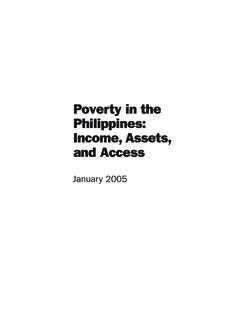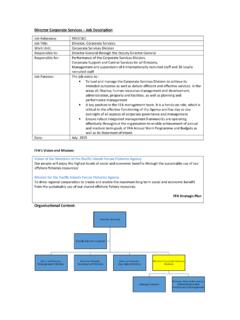Transcription of Youth unemployment in South Africa: causes and counter ...
1 Entry No: 1494 Undergraduate Page 1 of 13 Youth unemployment in South africa : causes and counter -measures South africa is currently struggling with large unemployment amongst the Youth . The National Development Plan has identified a number of policy interventions to improve Youth employment. In your view, what are the causes of Youth unemployment and what should government do to improve the levels of Youth employment? Identify the pros and cons of each of your proposals. Word count: 2200 words (incl. footnotes, excl. headings, references, & in-text references) Entry No: 1494 Undergraduate Page 2 of 13 1. Introduction unemployment is arguably the single most significant obstacle to poverty reduction in South africa (Ligthelm, 2006:30). The incidence of unemployment falls most harshly on young South Africans, who are generally low-skilled and have little to no experience of formal employment (National Treasury, 2011:12). It is exceedingly difficult for one of these unemployed young people to exit unemployment , and it is expected that a significant number of today s unemployed Youth will never achieve formal sector employment (National Planning Commission, 2012:106).
2 The National Development Plan (NDP) (National Planning Commission, 2012) seeks to address this significant issue by suggesting a number of policies which may reduce Youth unemployment . This paper will argue that one of the NDP s more controversial policies, that of a Youth wage subsidy, is a worthwhile policy and should be implemented, but with a regulated dismissal period. It will also argue that the government should encourage the growth of the South African informal sector. Section 2 describes the nature of unemployment in South africa , and section 3 goes on to analyse the causes of Youth unemployment . Section offers a broad approach within which unemployment -reduction policies should be theorised, and will then briefly outline the two most significant unemployment -reducing processes, education and economic growth, before explaining how intermediary policies are needed while these two processes develop. In section the Youth wage subsidy will be introduced and analysed, and the modified version put forward.
3 The paper will end by discussing the role that South africa s currently stunted informal sector could play in reducing Youth unemployment . 2. Characterising unemployment in South africa The South African labour market is characterised by significantly high levels of unemployment compared to other emerging-market economies (National Planning Commission, 2011:12-13). The South African labour force makes up just of the global labour force, but accounts for 2% of the world s unemployment (National Treasury, 2011:13). The local labour-force participation rate of is significantly lower than the rates of comparable countries (National Planning Commission, 2011:13), and the labour absorption rate of the formal economy has steadily declined since 1985 (Ligthelm, 2006:37), as Table 1 shows. However these broad pictures of unemployment do not reflect the sectional differentiation evident in the South African labour market. In particular, while the employment of non- Entry No: 1494 Undergraduate Page 3 of 13 youths in South africa is low compared to comparable emerging-market levels (8 percentage points lower), Youth employment in South africa is much lower still (24 percentage points lower), with further investigation emphasising this divergence (National Treasury, 2011:12).
4 Less than 17% of people over age 30 are unemployed in South africa , compared to 42% for people younger than 30 (National Treasury, 2011:5). Figure 1 illustrates that the incidence of unemployment falls largely on young people. Unemployed Youth in South africa are generally low-skilled and have little experience of employment, with two thirds of young people having never worked (National Treasury, 2011:5). Youth unemployment is a particularly serious issue in South africa because the country is experiencing a Youth bulge (National Planning Commission, 2012:98), which presents opportunities for growth if young people are meaningfully employed (McKinsey Global Institute, 2010:3), and the potential for serious social instability if they are not (National Planning Commission, 2012:106). More generally there are a plethora of reasons as to why unemployment is a negative phenomenon, from simple welfare effects, to output effects and other social consequences (Yu, 2012b:13).
5 3. The causes of Youth unemployment Up until 1994, numerous market distortions were caused by the industrial and social policies of the Apartheid government, with the effects of these distortions remaining evident in South africa today. Import Substitution Industrialisation induced an uncompetitive, capital-intensive economy, from which the majority of South Africans were excluded due to racial spatial policy and other measures (National Planning Commission, 2011:5). The relevant legacies of the Apartheid economy upon democratisation were uncompetitive primary and secondary industries which have consistently shed jobs since 19941 (National Planning Commission, 2011:13), and an unskilled, spatially misaligned labour force, with the majority of South Africans having been denied quality education (National Planning Commission, 2012:110, 114). South African economic growth has occurred largely in skills-intensive sectors, such as the financial and business services sector (Hausmann, 2008).
6 It is generally accepted that the primary cause for South africa s widespread unemployment today is a structural mismatch between the skills the modern South African economy demands, and the skills it supplies (Hausmann, 2008) (National Planning Commission, 2011:15), with the ratio 1 2004 mining employment was 29% lower than 1994 levels; 2004 agricultural employment was lower, and manufacturing sector employment declined (National Planning Commission, 2011:9) Entry No: 1494 Undergraduate Page 4 of 13 of skilled to unskilled employment having changed from 35:65 between 1970 and 1975, to 53:46 between 2000 and 2002 (Ligthelm, 2005:42). The shortage of suitable jobs has been compounded by significant increases in labour force growth since 1994 (Hausmann, 2008). As already described, South African Youth are low-skilled, and the skills mismatch that applies to the broader South African economy applies particularly to them.
7 The principal reason given by employers for their low Youth employment is that with schooling not accurately indicating skill levels (National Treasury, 2011:16), unskilled inexperienced workers are seen as risky to employ, thus increasing their real cost (National Treasury, 2011:5-6). The causes of South African Youth unemployment then, are a combination of deficient demand for labour, due to the increasingly skills-intensive orientation of the South African economy, and substandard supply, caused by the emergence of risky low-skilled Youth . Approaching remedies: broad focus Godfrey (2003:1) proposes an analytical framework which sorts unemployment -reducing policy interventions into being either preventative or curative. Preventative measures are those which aim to address the causes of a problem, whereas curative measures address symptoms, and he argues that preventative solutions are generally superior (Godfrey, 2003:1). With the principal cause of Youth unemployment being a structural mismatch of skills, it follows that preventative measures would aim to address this.
8 In looking to address the fundamental issue of unskilled, deficient labour supply, the key preventative reform is instituting higher quality, more widely accessible education (National Treasury, 2011:19). This has been recognised by the National Planning Commission (2012:70-71) and the South African Government, with a number of policies having been formulated (National Treasury, 2011:9) and more than 20% of national expenditure being allocated towards education, including R23 billion towards infrastructure development (Gordhan, 2013:25, 33). However a number of issues in education remain unresolved, and a long-term reduction of Youth unemployment requires that they be better addressed (Equal Education, 2013). The second preventative development required is rapid and sustained inclusive economic growth, which would address deficiencies in the demand for young low-skilled labour. Sustained inclusive growth between 2003 and 2008 created in excess of 2 million jobs, and Entry No: 1494 Undergraduate Page 5 of 13 lowered the strict unemployment rate from to (National Treasury, 2011:10).
9 The employment growth of this period was higher than in most other emerging economies and was highly labour-absorbing (National Treasury, 2011:18), as can be seen in Figure 2. The importance of growth for employment was emphasised in a negative fashion after the 2008 global recession, which resulted in the loss of 1 million South African jobs and disproportionately affected young people (National Planning Commission, 2011:6). It is important to note that while the above two preventative measures do address the underlying causes of Youth unemployment , the realisation of their aims will occur only in the long-run. There is therefore a need for policy which will address at least the symptoms of Youth unemployment in the short-term (Levinsohn, 2007:22). These curative measures, called active labour market policies (ALMPs), aim to quickly improve the employability of the Youth and increase demand for labour (National Treasury, 2011:19-20). The ALMP this paper focuses on is the Youth wage subsidy as proposed by the National Treasury (2011) and the Democratic Alliance (2012).
10 2 Narrow focus: Youth wage subsidy The Youth wage subsidy suggested by the National Treasury (2011:7) is a tax rebate awarded to employers when they employ low-skilled workers between the ages of 18 and 29 who earn below the income tax threshold. The maximum value of the rebate per worker per year is R12 000, and it will be available for a maximum of two years, with a number of factors determining the size of the grant in specific cases (Yu, 2012b:11). The purpose of the subsidy is to boost labour demand, and in doing so increase employment (National Treasury, 2011:24). The mechanism through which this occurs is by reducing the cost of employing a young person, and therefore mitigating the financial risk associated with hiring inexperienced low-skilled Youth (Yu, 2012b:12). This reduces the gap between the cost of employing a worker and that worker s productivity, while leaving wages unaffected (Yu, 2012b:12). In addition to achieving short-term employment, it is hoped that young people will develop on-the-job skills, and will be productive enough by the end of the subsidised period to retain employment, or find unsubsidised employment elsewhere (National Treasury, 2011:10).






